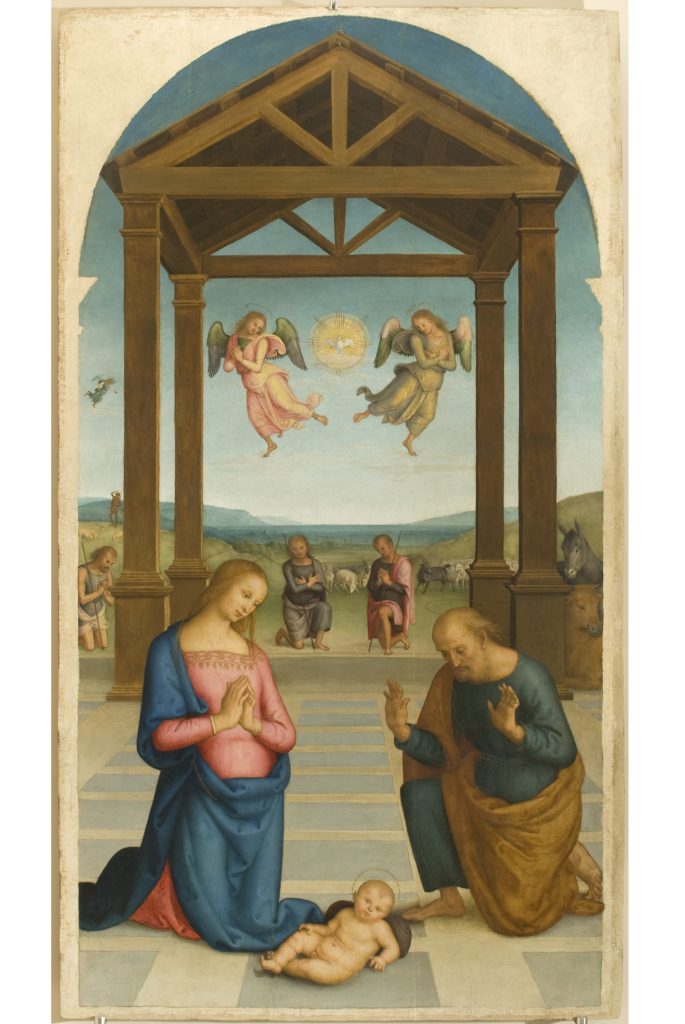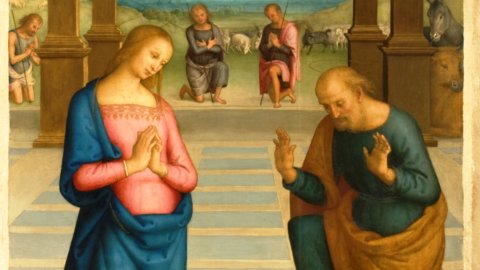The painting, a large panel (263×147 cm), from the Galleria Nazionale dell'Umbria in Perugia, is hosted until to 28 January 2018 at the Carlo Maria Martini Diocesan Museum in Milan.
The work is the undisputed masterpiece of Pietro Vannucci's maturity, known as il Perugino (Città della Pieve, Perugia 1448/50 - Fontignano, Perugia, 1523) and is part of a polyptych executed for the church of Sant'Agostino in Perugia, commissioned by the Augustinian friars in 1502.
Its complex execution took more than twenty years and, when the painter died, some finishing touches were still missing. It was in fact a grandiose altarpiece, with several compartments and on several registers, which must have been more than eight meters high and which was made up of over thirty tables.
As early as 1654 the imposing structure, not in keeping with the new liturgical provisions of the Counter-Reformation, was dismantled and divided into two parts. From that moment, unfortunately, the dispersion of the tables began. Many of them are now in France, due to the requisitions made by Napoleon's troops in 1797, in the United States, such as the St. Bartholomewpreserved in the city of Birmingham in Alabama, or in Perugia, in the Benedictine church of San Pietro, where the Christ supported by Nicodemus between the Sorrowful Madonna and Saint John the Evangelist.
In addition toAdoration of the Shepherds, the other compartments with Eternal Blessing, Prophets Daniel and David, Archangel Gabriel, Baptism of Christ, Saints Jerome and Mary Magdalene, and twelve compartments of the predella.
There have been numerous attempts to recompose the original layout of the large polyptych.
The exhibition design, curated by the architect. Alessandro Colombo of Studio Cerri & Associati will try to suggest the architectural space for which the work was intended and to evoke the grandiose polyptych of which it was part.
Perugino returned to Perugia on the threshold of the sixteenth century, commissioned, after successes obtained throughout Italy, to decorate the walls of the Collegio del Cambio, the fresco cycle which qualified him as the greatest exponent of an artistic reality capable of competing with what was happening in Florence.
These were years in which, after the entry of the young Raphael into his Florentine workshop, Perugino resumed fifteenth-century schemes already used in the past but often, also due to the influence of the gifted pupil, infused them with new inventiveness and great refinement, without ever renouncing a simple, pure and moving.
The formal purity, the clear and elegant design, the balanced composition and the sweetness of his figures are elements present in his works up to his maturity, as can also be found in theAdoration of the Shepherds, in which Perugino takes up the scheme already tried in the fresco of the Collegio del Cambio in Perugia.

To the left of the table, we can see the announcement of the angels to the shepherds, who also appear in the centre, in adoration. To the right, the ox and the donkey. In the centre, between two angels, the dove of the Holy Spirit appears and, in the foreground, Mary and Joseph adore the Child, resting on the ground and protected only by a flap of the Virgin's mantle. Instead of the classical loggia, a simple hut appears here.
The landscape background is rendered to its essentials and the figures, on which all the artist's attention is concentrated, rest on a perspective floor.
Perugino's style marks the beginning of a new way of painting which, starting from Raphael, the most important of his pupils, will mark the birth of the modern way.
The initiative is curated by Nadia Righi, director of the Diocesan Museum of Milan and Marco Pierini, director of the National Gallery of Umbria, with the patronage of the Archdiocese of Milan, the Pontifical Council for Culture, the Lombardy Region, the Umbria Region, the Municipality of Milan, the Municipality of Perugia, with the contribution of Ubi Banca; Trenord special partners.





